5.3: SYMBOLISM AND ICONOGRAPHY
- Page ID
- 10138
Symbolism refers to the use of specific figural or naturalistic images, or abstracted graphic signs that hold shared meaning within a group. A symbol is an image or sign that is understood by a group to stand for something. The symbol, however, does not have to have a direct connection to its meaning. For example, the letters of the alphabet, which are abstract graphic signs, are understood by those who use them to have individual sounds and meanings. The users have assigned meaning to them, as letters have no meaning in and of themselves. An example of a naturalistic image is a rose, which in most Western civilizations symbolizes love. When one person gives a rose to another, it is a symbol of the love the person feels.
Iconography is the broader study and interpretation of subject matter and pictorial themes in a work of art. This includes implied meanings and symbolism that are used to convey the group’s shared experience and history—its familiar myths and stories. Iconography refers to the symbols used within a work of art and what they mean, or symbolize. For example, in different cultures a snake may stand for evil, temptation, wisdom, rebirth, or the circle of life. A depiction of a snake in a scene with Adam and Eve has specific meanings for those of the Christian faith or others who understand the snake stands for temptation within the context of that subject or story. In Chinese culture, however, a snake represents the power of nature and is said to bring good fortune to those who practice the snake’s restraint and elegance of movement.
5.3.1 Changes in Meaning of Symbols and Iconography
While a symbol might have a common meaning for a certain group, it might be used with variations by or hold a different significance for other groups. Let us use the example of a cross. At its core, a cross is a simple intersection of vertical and horizontal lines that could refer to the meeting of celestial and terrestrial elements or forces or could lend itself to other variations of meaning. The cross most frequently associated with Christianity is the Latin Cross, with the long vertical bar intersected by a shorter horizontal one believed by many to be the form of the cross upon which Jesus Christ, the central figure of the faith, was crucified. (Variants of the Cross: http://wpmedia.vancouversun.com/2010...6.crosses1.png) But its simplicity of conception lends itself to various other readings, as well, and in pre Christian use it was related to sacred and cosmic beliefs.
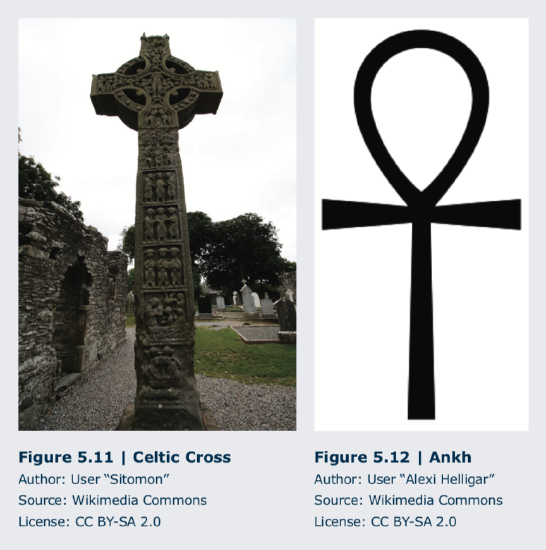
Within Christian usage, the cross has taken a great number of different of forms, including the equal-armed Greek Cross, favored by the Byzantine Christians; Celtic crosses, with a circular addition to the crossing; X’s and upside-down crosses associated with specific Christian martyrs, individuals who died for their faith, on such instruments of torture; and many others. In art, we might see them as simple flat graphic works, or decorated in two-dimensional renditions, or as fully developed three-dimensional interpretations, like the numerous grave markers in Irish cemeteries, where they are further embellished with intricate motifs and iconographic depictions of Bible stories. (Figure 5.11)
The Ankh, another cross form, with a looped handle, seems to have been devised by the ancient Egyptians as a symbol of the life-giving power of the Sun. (Figure 5.12) It was one of the numerous pictographic symbols they used both as a separate sign and as part of the hieroglyphic system of writing they developed.
Clearly, many other symbols have various meanings, especially when they are represented as more abstract graphic signs. To read their implications in any particular application will require your considering where it was made and for what specific purposes, as well as how it might have been adopted and turned to different use at that time or later. Sometimes the shifts in meaning may be radical, as in the form of the swastika, an ancient sacred sign used in many different cultures, including India and others throughout Asia, as well as the Near East, and Europe. (Figures 5.13, 5.14, and 5.15) It has historically been a very auspicious sign with implications of good fortune and positive movement, and was therefore adopted for the ground plan for Buddhist stupa worship centers. Of course, in the twentieth century, its appropriation by the Nazi Party as a symbol of the superiority of the Aryan heritage led to very different and now generally negative connotations.
Iconography is often more specific and definitive, with concrete reference to world experiences and, beyond that, to some form of narrative for the group involved. Again, analysis of the pictorial form requires examination of the con- text in which the artwork was created. We can and must look at the underlying narrative, but, as we shall discuss in the next several chapters, the pictorial expressions evolve both independently of the narrative sources and in response to narrative and artistic change.



For example, Christians (more specifically that branch now known as Roman Catholics) debated the “true nature” of the Virgin Mary, the Mother of Jesus Christ. Among the points of debate was whether Mary was bodily in Heaven with her Son or whether she had to wait until the end of time when the whole of mankind would experience bodily resurrection, that is, at the time of the Second Coming and the Last Judgment, when everyone would have their lifetime of deeds assessed for purposes of learning whether they would spend eternity in Heaven or Hell. These Christian ideas are among those a great amount of art has been devoted to over time.
To illustrate, we can look at differences between two works about Mary and her place and role in Heaven that appeared in church relief sculpture during the twelfth and thirteenth centuries. These differing ideas focused on the implied elevation of Mary to a divine status, or to her not being seen as divine herself, in which case, the faithful needed to keep a view of her as being in a more subordinate or secondary status. The questions included consideration of Mary as the “Queen of Heaven,” who might be ruling alongside her son. At Senlis Cathedral (1153-1181) in France, she was depicted as apparently a co-ruler with Christ, but ensuing theological discussion took issue with this possible over-elevation. (Figure 5.16) So, while the renditions of Mary as the celestial queen continued in popularity, they made it clear that she was only considered to be there at the bidding and will of Christ. This can be seen at Chartres Cathedral in France, where she bows her head to Jesus. (North Portal of Notre-Dame Cathedral: https://www.bluffton.edu/~sullivanm/ chartresnorth/cportal.html)
What we see here, again, is that our full analysis of the artworks we encounter needs a complex approach that includes a variety of visual clues and a wide range of research on the contextual details of its creation and use. In contrast to the longstanding assertion that “beauty is in the eye of the beholder,” the appropriate interpretation according to the intended symbolism and/or iconography must take the society, culture, and related circumstances into account to accurately reflect its intended meaning or original meaning for viewers. We will be exploring these ideas in greater detail in the next several chapters.
5.3.2 Symbolism, Iconography, and Visual Literacy
Symbols like the cross or the swastika will only have shared meaning for those who agree upon and affirm a specific interpretation, which can be positive or negative for any particular group of people. This specific meaning in symbols is always going to be the case for viewing of any visual expression, whether in simplified graphic sign form or a more detailed pictorial rendition. Additionally, the viewers must also often have some measure of instruction about how to view a particular work so they can understand its meaning more fully.
 Also noteworthy is that members of any group use art as a means of sharing ideas and sentiment, as well as for expressing and teaching ideology. While the didactic uses of art have often been discussed in terms of instruction for the non-literate, we should recognize that the meanings of pictorial content and the tools used to create the picture must be learned as well. The apparent superficial meanings that are evident through unschooled visual examination do not produce the level of comprehension available in a more fully developed illustration of a tenet of a faith, political message, history lesson, or chart or graph of economic trends. So “visual literacy” should be considered a skill related to verbal and reading literacy for any didactic function. Only members of a group who have been led to understand and perceive the underlying principles will know how to “read” an illustrated message.
Also noteworthy is that members of any group use art as a means of sharing ideas and sentiment, as well as for expressing and teaching ideology. While the didactic uses of art have often been discussed in terms of instruction for the non-literate, we should recognize that the meanings of pictorial content and the tools used to create the picture must be learned as well. The apparent superficial meanings that are evident through unschooled visual examination do not produce the level of comprehension available in a more fully developed illustration of a tenet of a faith, political message, history lesson, or chart or graph of economic trends. So “visual literacy” should be considered a skill related to verbal and reading literacy for any didactic function. Only members of a group who have been led to understand and perceive the underlying principles will know how to “read” an illustrated message.
For example, we can look at the Ritual Vase from Warka (today Iraq) or the Seven Sacraments Altarpiece by Rogier van der Weyden. (The Warka Vase: http:// dieselpunk44.blogspot. com/2013/08/the-warka- vase.html) (Figure 5.17) One could likely identify the basic pictorial content of either work, but further knowledge would be needed to analyze them further. If you were a member of the intended audience, you might have a bit more insight into what each artist had created in pictorial terms, but even the initiated viewer would likely have a limited “reading” of the work.
In the case of the Ritual Vase from Warka, even if you had lived in ancient Sumer and had been a devotee of the goddess Inanna, you would likely need further instruction about how the carvings on the different registers of the vase were arranged to show the cosmological conception of the created world. That is, one starts at the bottom with the primordial earth and waters, moves to the plants and animals above them drawing sustenance so that they could be harvested and herded by the humans, who then offer part of their gleanings to the goddess serving them from the temple as seen in the upper realm of the middle photograph. This design would be further explained as a neatly hierarchical arrangement, in which the levels of the created world were presented in different sizes, according to their relative importance. Additional meanings could be layered upon this cursory explanation with repeated teaching occasions and viewings.
The Seven Sacraments Altarpiece was painted by Rogier van der Weyden in a region and an era of tremendously complicated iconography: Flanders during the Late Gothic/Northern Renaissance period. The presentation here includes detailed pictorial description of each of the seven sacraments that marked the stages and stations of Christian life. This symbolism again developed over time, and often in response to theological writings that informed the artist and the viewer about specific meanings. The written sources are detailed and complex, with the pictorial rendition richly reflecting what the well-instructed Christian would know about these important rituals and their effects.
The larger central panel of the triptych, or three-part, format was used by the artist to emphasize the Crucifixion as the dominant overarching event that is related to each of the sacraments. Additionally, he provided angels with scrolls to identify them as if speaking to the viewer. So, here the messages are both pictorial and inscribed, and the iconography is a complex program that relates all these ritual events to the whole of the Christian life and faith. Truly, the viewer must be an initiate to discern the meanings behind all the symbolism or a scholar to discover them. Nonetheless, even the casual or uninitiated can read much of what is present in the painting and can identify both familiar elements and those that might lead you to further investigation. This is often the task and the path in interpretation of iconography in art.
5.3.3 Symbolism and Iconography in Mythology and Storytelling
From early on, art contained expressions of mythical accounts that people shared about their beliefs and ways of living. From the time of the first great civilizations, for example, in Egypt, the Near East, China, Japan, and India, artwork related to the stories of the people. The degree to which any contemporary written sources confirm these interpretations varies, but that these myths had commonly understood meanings for the people for whom they were made is confirmed by both their frequent appearance and their apparent places in their culture’s artistic traditions, sometimes over centuries. Artistic iconographic traditions therefore show strong relationships to beliefs and practices known from written sources—although written documentation sometimes does not appear until later times.

Because early stories were often passed along through oral tales, we do not always have a literary record of them until later times, even after the ideas had been expressed symbolically in pictorial art. An example of this symbolism may be found in the rich hoard (a collection of objects) known as the Sutton Hoo Ship Burial, found in England and deriving from the early Middle Ages era known as the Migration period (300-700 CE). Although the wooden ship itself has disintegrated, the burial hoard it contained provides details that confirm and broaden our incomplete understating of the adventurous societies of that time and their beliefs about needs for the afterlife. The diverse objects also lend certain insights into the epic tales of such warrior kings as Beowulf, whose story seems to have been a long-standing oral tradition, one perhaps re-told for centuries before being commit- ted to written form. The lavish ornaments, such as this belt buckle and purse cover, give visual testimony to the tales of dragons and heroes like Beowulf through their expressive and intricate patterns and rich materials. (Figures 5.18 and 5.19) The fine metalwork on the purse cover is cloisonné,which is created by affixing gold or metal strips to the back surface, making compartments, that are filled with powder (in this case, ground garnets) and heated to 1,400-1,600 degrees F.
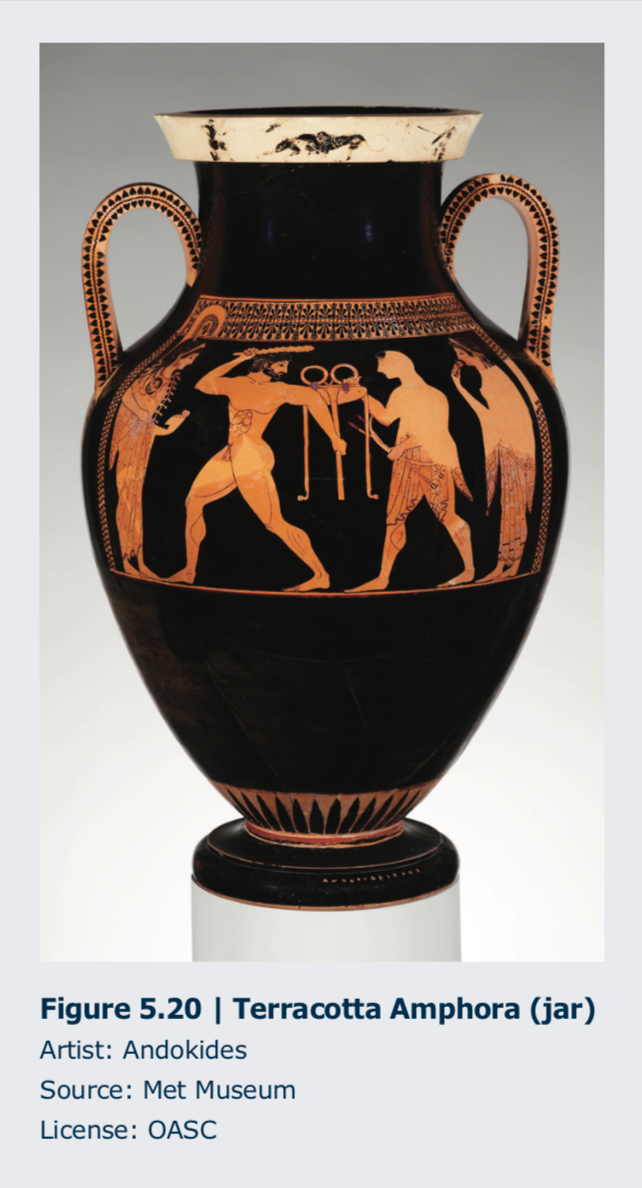
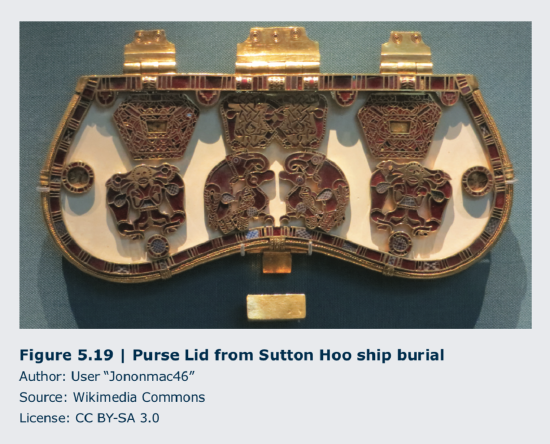 The art of ancient Greece often showed great concern with the stories of Greek mythology as well. Tales of the gods and warriors abound, including those about great physical or intellectual contest, such as the well-known struggles of Herakles (known as Hercules under the Romans) one of which is seen on this amphora. (Figure 5.20) Such tales were very familiar, and viewers were expected to supply the details of the rest of the story through the parts that were shown. However, the skillful artist can enliven the presentation of the figures with posture, gesture, expression, and such symbolic props as the club and the tripod Herakles holds.
The art of ancient Greece often showed great concern with the stories of Greek mythology as well. Tales of the gods and warriors abound, including those about great physical or intellectual contest, such as the well-known struggles of Herakles (known as Hercules under the Romans) one of which is seen on this amphora. (Figure 5.20) Such tales were very familiar, and viewers were expected to supply the details of the rest of the story through the parts that were shown. However, the skillful artist can enliven the presentation of the figures with posture, gesture, expression, and such symbolic props as the club and the tripod Herakles holds.
As with literary accounts, the artworks associated with historical and legendary events often include a very wide range of symbols and imagery to help convey ideas. These range from mundane details to grand historical moments, as in the Column of Trajan, nearly 100 feet in height, which commemorates the military campaigns of Roman Emperor Trajan (r. 98-117 CE) against the Dacians (101-102 and 105-106 CE) in 155 scenes. (Figure 5.21) Or as appear in the Bayeux Tapestry, an embroidered cloth 230 feet in length that pictorially recounts the events of the Norman Invasion and Battle of Hastings in 1066. (Figure 5.22) Each of these works shows decisive points in their respective historical events in army operations and in the details of the hard work involved in preparing for battle. (Figures 5.23 and 5.24) In this way, they provide us with glimpses of everyday life in the respective eras alongside specific details about the particular campaigns, the cultures in which they were significant, and the individuals who were key players in the historical events. The details of arms and armor, organized troops and chaotic fighting, building of defensive structures and devices, moments of victory and defeat, and innumerable other items and activities—all are individually and collectively efficient means of recounting the evolution of the events which, in each of these works, is dramatically developed across a long scrolled compositional field that further emphasizes the lengthy narrative each one progressively disclosed.


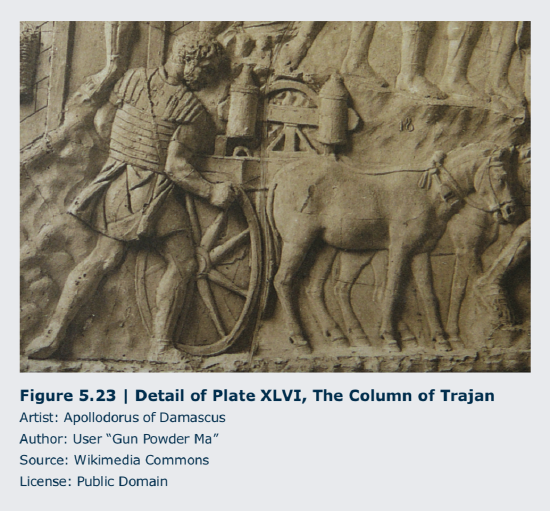
Like many works of public art of the Roman Imperial era, the column glorifies not only Trajan (the base of the column was designed to contain his ashes) and his deeds, but also the ideas of imperial rule, the role of conquest in expanding the Empire, and the skilled work of Roman soldiers in battlements and tactics. By contrast, the Bayeux Tapestry has more emphasis on the actual tumultuous battle scenes replete with mounted cavalry in chain mail and elaborate helmets but it also includes a great deal more sense of historical con- text: events leading up to the 1066 Battle of Hastings after the death of King Edward the Confessor (r. 1042-1066) and his burial in the newly refurbished Westminster Abbey he had adopted as his royal church. Both of these works also include inscriptions that explicate ideas and events, as well as serve to further present the political messages about the battles presented on the tapestry in a sort of scene-by-scene narrative again, for each, underscoring the relationships between literary and pictorial presentations of ideas.
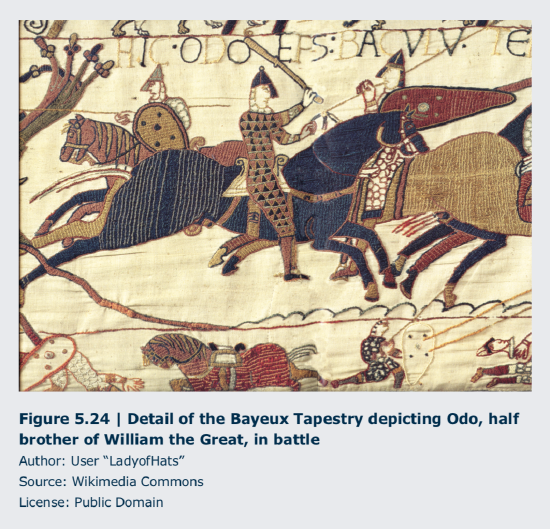 5.3.4 Exploring Symbolic and Iconographic Motifs
5.3.4 Exploring Symbolic and Iconographic Motifs
Such items as arms and armor are obvious sorts of symbols that clearly depict their purposes, but much symbolism that we see in other artworks has more veiled and variable meaning. Such simple items as flowers and candles can be used in very complex ways in pictures that carry diverse meanings, thus requiring careful study and even deep research in order to discern their implications in a particular work.
For example, the Merode Altarpiece by Robert Campin (c. 1375-1444, Belgium) depicts the Christian story of the Annunciation to the Virgin Mary by the Angel Gabriel that she will become the Mother of Christ, the son of God. (Figure 5.25) This work is full of symbols that have been widely studied to discern and interpret their messages. The lilies are generally interpreted to symbolize the purity and virginity of Mary in other pictures, though, they might have other meanings, including reference to death, resurrection, birth, motherhood, or other events or conditions. Within this one work, the use of the candle, just extinguished with a trail of smoke, is given several different meanings by diverse viewers and scholars. It might show the moment of acquiescence, when Mary agrees to bear the Christ child, in which God takes human form. It has also been read as a foreshadowing of Christ’s death, of human death in general, and of the fleeting nature of life for all.
In the time and place of the altarpiece’s creation, symbolism in paintings was particularly apt to be rich and varied, offering the viewer/believer a lot to see and to contemplate further. In this way, if the symbols could be read in different ways, they could then provide ongoing stimulus for meditative reflection on the diverse levels of meaning.
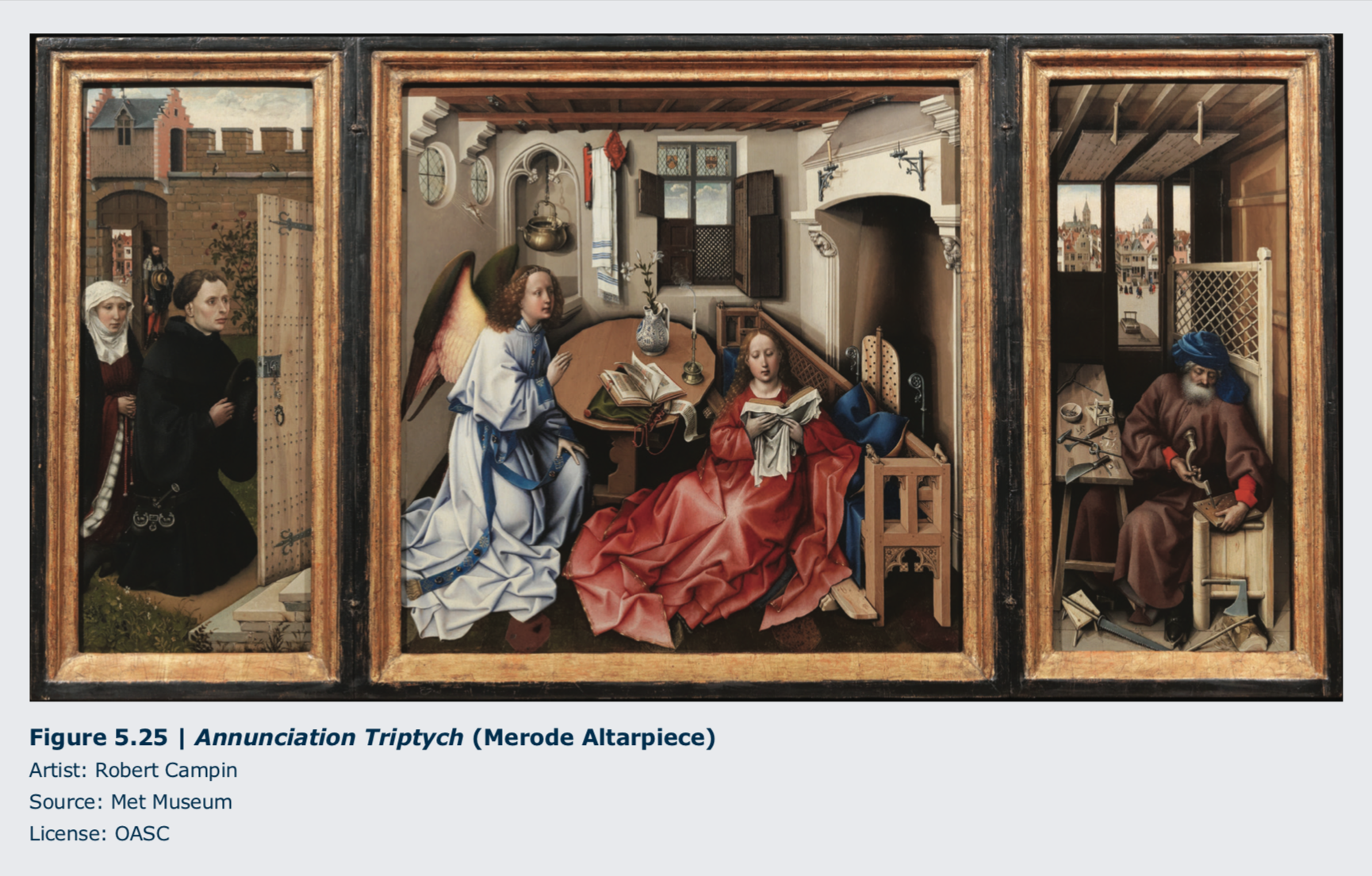

For example, the Merode Altarpiece by Robert Campin (c. 1375-1444, Belgium) depicts the Christian story of the Annunciation to the Virgin Mary by the Angel Gabriel that she will become the Mother of Christ, the son of God. (Figure 5.25) This work is full of symbols that have been widely studied to discern and interpret their messages. The lilies are generally interpreted to symbolize the purity and virginity of Mary in other pictures, though, they might have other meanings, including reference to death, resurrection, birth, motherhood, or other events or conditions. Within this one work, the use of the candle, just extinguished with a trail of smoke, is given several different meanings by diverse viewers and scholars. It might show the moment of acquiescence, when Mary agrees to bear the Christ child, in which God takes human form. It has also been read as a foreshadowing of Christ’s death, of human death in general, and of the fleeting nature of life for all.
In the time and place of the altarpiece’s creation, symbolism in paintings was particularly apt to be rich and varied, offering the viewer/believer a lot to see and to contemplate further. In this way, if the symbols could be read in different ways, they could then provide ongoing stimulus for meditative reflection on the diverse levels of meaning.

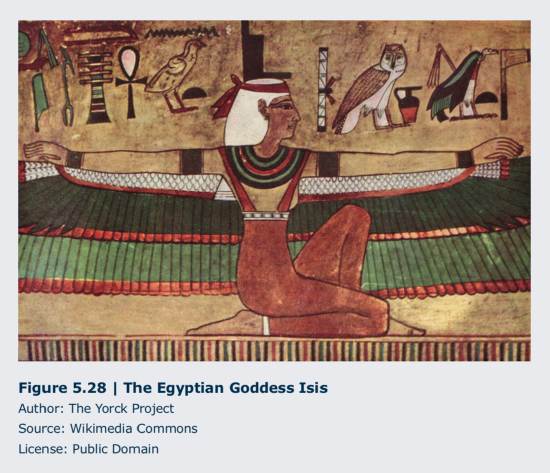 And some symbolic motifs, distinguishing features or ideas, carry different meaning in one context from what they might in another. Most symbols are not universal, although they often bear related meanings in diverse contexts. For instance, the sort of figure you might identify as an angel, that is, a winged creature with a human-like bodily form, has appeared in the art of many different cultures. They generally represent beings that can travel between the terrestrial and celestial realms, but their more specific roles can vary widely, for good or evil purposes. The Angel Gabriel, just seen in the Merode Altarpiece, was a messenger from God, according to the Christian tradition. This motif was built upon the Jewish tradition of angels sent from God for bringing news or instructions, or intervening as needed. Islamic interpretations, also building on the same traditions, are similar although the figural representation is less common in Muslim artwork.
And some symbolic motifs, distinguishing features or ideas, carry different meaning in one context from what they might in another. Most symbols are not universal, although they often bear related meanings in diverse contexts. For instance, the sort of figure you might identify as an angel, that is, a winged creature with a human-like bodily form, has appeared in the art of many different cultures. They generally represent beings that can travel between the terrestrial and celestial realms, but their more specific roles can vary widely, for good or evil purposes. The Angel Gabriel, just seen in the Merode Altarpiece, was a messenger from God, according to the Christian tradition. This motif was built upon the Jewish tradition of angels sent from God for bringing news or instructions, or intervening as needed. Islamic interpretations, also building on the same traditions, are similar although the figural representation is less common in Muslim artwork.
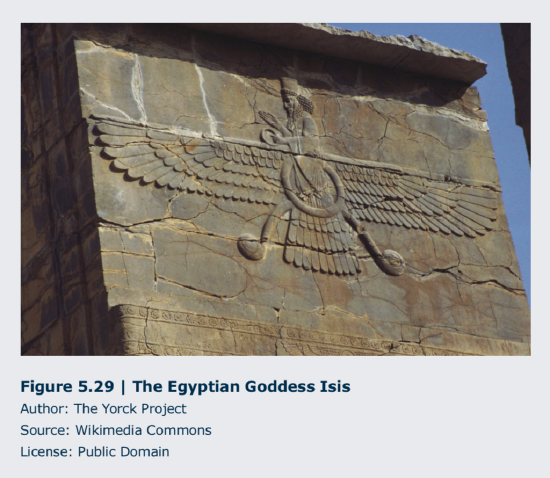
Prior to such figures, winged creatures known as Nikes were depicted by ancient Greek and Roman artists to show a moment of victory, sometimes, as is the case here, further symbolized by the award of a fillet, a band wrapped around the head, or laurel wreath. (Figure 5.26) These winged figures were sometimes gods or goddesses. The genie figures that adorned palace walls in the ancient Near East, including horses, bulls, lions, and other animals, were also winged to show their superior and sometimes god-like powers or origins. (Figure 5.27) Other examples include the goddess Isis of an- cient Egypt, and the Persian god Ahura Mazda. (Figures 5.28 and 5.29)
Another set of prominent Christian iconographic motifs are the winged symbols which often represent the Four Evangelists in art: Matthew is the winged man or angel; Mark, the winged lion; Luke, a winged ox; and John, an eagle. (Figure 5.30) At the same time they refer to four key events in the life of Christ: the Incarnation, Passion, Resurrection, and Ascension. Interpretations of these evangelist symbols are rooted in the Old Testament Vision of Ezekiel and the New Testament Book of Revelation, as related by the writings of St. Jerome in the fifth century CE. They accrued additional iconographic details over the centuries, with implications of their status as the special creatures who surround the celestial throne of God again, signifying that the wings facilitate movement between the realms traditionally ascribed to a deity, a god or goddess, and divinely related creatures. This use of wings clearly reflects human contemplation of the abilities that birds have to defy gravity and to express artistically the lofty aspirations of the earthbound.
Another frequently used iconographic motif that appears across the ages and across cultures is the halo, usually a circular area of light appearing behind the head of a person or creature. One example is the halo that appears behind the heads of Christ and the symbolic winged creatures in Figure 5.30. Note that Christ’s halo has a cross form embedded in it, and his entire body is surrounded by a circle of light (made up of four arcs) known as an aureole or mandorla. Such devices, in many related forms, indicate a radiance that surrounds certain figures, showing their sanctity, divinity, or divine favor. It indicates their aura of holiness, with implications of their being infused with warmth, inflamed with divinity or with divine love. In some of the Asian versions, notably Hindu or Buddhist, the radiance is literally comprised of flames.
Frequently seen, as well, are such items as crowns, thrones, regalia like scepters, garments like official capes, monks’ robes, or uniforms of all varieties indications of a person’s belonging to a specific group, class, or office that lead the viewer to identify some specific aspect of who the person might be and what role they have in the depiction. The positioning of figures relative to one another should also be read in order to discern meaning, interactions, relative rank, and other implications. The types of garb, accompanying items, and positioning often relate the message to a specific time and place by giving historical and cultural context through details of style or motifs used.

 For example, on the stele depicting his victory over the Lullubi, the Akkadian ruler Naram Sin (r. c. 2254-2218 BCE) wears a horned helmet and is much bigger than the men around him. (Figure 5.31) He ascends the mountain as his enemies beg for mercy under the watch of astral deities, and that shows his relationship to them as the source of his power and right to rule. In the Ghent Al- tarpiece by Jan van Eyck (c. 1390-1441, Belgium), we can also see a variety of such motifs: Christ, wearing the papal ti- ara as a crown; Mary, richly dressed and humbly reading; and John the Baptist, in his garment of penitence, and preaching. (Figure 5.32) Adorned with jewels and gold on his clothing, the throne on which he sits, and the crown at his feet, Christ is here being shown as the king of Heaven as well as Earth.
For example, on the stele depicting his victory over the Lullubi, the Akkadian ruler Naram Sin (r. c. 2254-2218 BCE) wears a horned helmet and is much bigger than the men around him. (Figure 5.31) He ascends the mountain as his enemies beg for mercy under the watch of astral deities, and that shows his relationship to them as the source of his power and right to rule. In the Ghent Al- tarpiece by Jan van Eyck (c. 1390-1441, Belgium), we can also see a variety of such motifs: Christ, wearing the papal ti- ara as a crown; Mary, richly dressed and humbly reading; and John the Baptist, in his garment of penitence, and preaching. (Figure 5.32) Adorned with jewels and gold on his clothing, the throne on which he sits, and the crown at his feet, Christ is here being shown as the king of Heaven as well as Earth.
5.3.5 Metaphorical Meanings
The metaphorical meanings of specific artworks also depend upon a certain level of viewer knowledge and insight. A metaphor is a figure of speech in which one thing symbolically stands for another, perhaps unrelated, thing or idea.
In 1550 Chairs Stacked Between Two City Buildings by Doris Salcedo (b. 1958, Columbia), we see a metaphorical treatment of life change. (1550 Chairs Stacked Between Two City Buildings, Doris Salcedo: http://www.mymodernmet.com/profiles/...s-salcedo-1550 chairs-stacked) It is a view of displacement resulting from a 1985 uprising in her Colombian homeland that left many migrants displaced or dead, as well as similar catastrophic events in locales across the globe. The jumbled mass of furniture alludes to the upheaval of lives that are overturned by mass violence and terrorism, often of those already without roots, community, or stable lifestyles. The victims, frequently anonymous and relatively invisible in the site of such a revolt, nonetheless left some hints of their presence in the chaotic remnants of their fleeting existence, in a place where they had established so little sense of their individual identities. Her metaphorical expression gives a probing glimpse of the devastation such events have wrought around the world.



